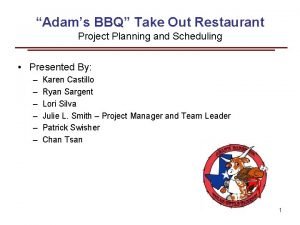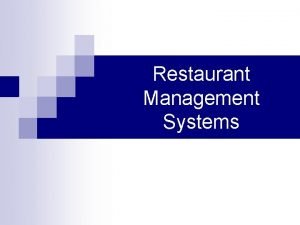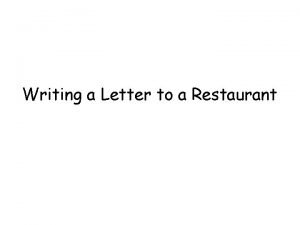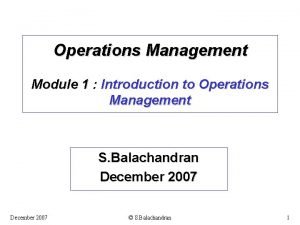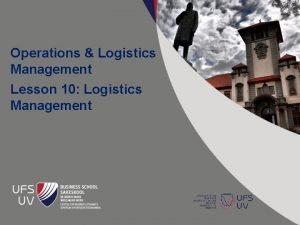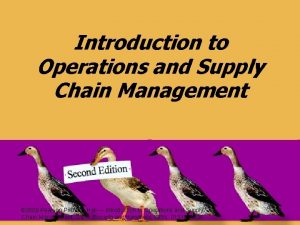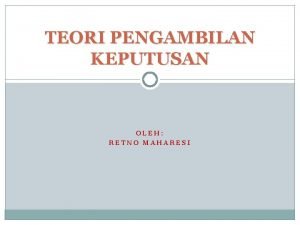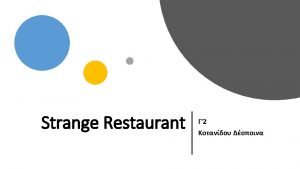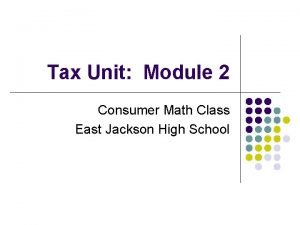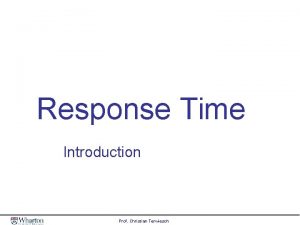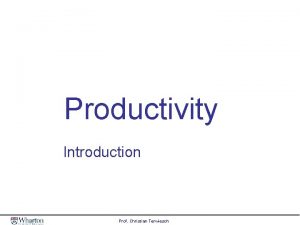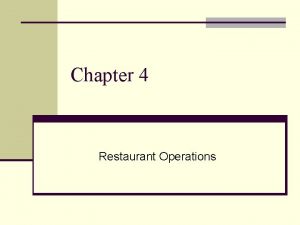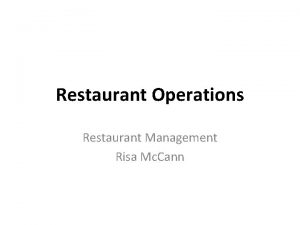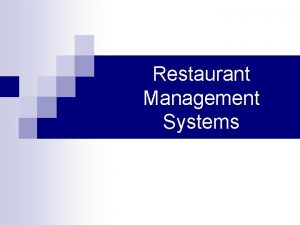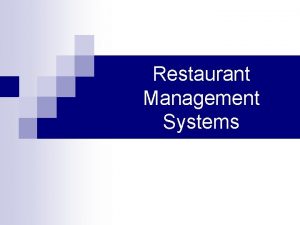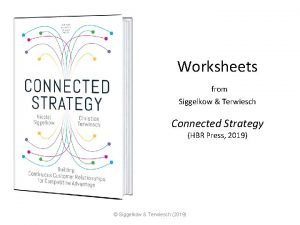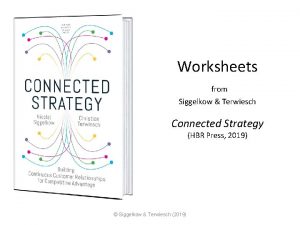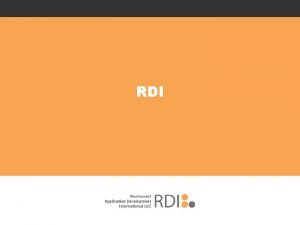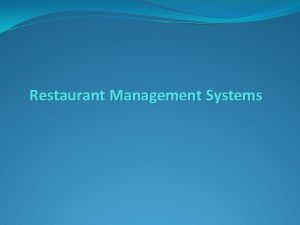Introduction Prof Christian Terwiesch Operations in a Restaurant

















- Slides: 17

Introduction Prof. Christian Terwiesch

Operations in a Restaurant Prof. Christian Terwiesch

Operations in an Emergency Room Prof. Christian Terwiesch

Operations from the Perspective of the Customer Prof. Christian Terwiesch

Four Dimensions of Performance Quality Cost ▪ Efficiency ▪ Product quality (how good? ) ▪ Process quality (as good as promised? ) Variety Time ▪ ▪ Customer heterogeneity Important for - Performance measurement - Defining a business strategy Prof. Christian Terwiesch Responsiveness to demand

Four Dimensions of Performance: Measurements for a Sandwich Store Cost ▪ Efficiency Quality ▪ Product quality (how good? ) ▪ Process quality (as good as promised? ) Variety Time ▪ ▪ Customer heterogeneity Responsiveness to demand Prof. Christian Terwiesch

Introduction Efficient Frontier Prof. Christian Terwiesch

Four Dimensions of Performance: Trade-offs Quality Cost ▪ ▪ Efficiency ▪ Measured by: - cost per unit - utilization Product quality (how good? ) => Price ▪ Process quality (as good as promised? ) => Defect rate Variety Time ▪ ▪ ▪ Responsiveness to demand ▪ Measured by: - customer lead time - flow time Customer heterogeneity Measured by: - number of options - flexibility / set-ups - make-to-order Prof. Christian Terwiesch

What Can Ops Management (This Course) Do to Help? Step 1: Help Making Operational Trade-Offs Responsiveness High Very short waiting times, Comes at the expense of Frequent operator idle time Tradeoff Low Long waiting times, yet operators are almost fully utilized Low labor productivity High labor productivity Labor Productivity (e. g. $/call) Example: Call center of a large retail bank - objective: 80% of incoming calls wait less than 20 seconds - starting point: 30% of incoming calls wait less than 20 seconds - Problem: staffing levels of call centers / impact on efficiency OM helps: Provides tools to support strategic trade-offs Prof. Christian Terwiesch

What Can Ops Management (This Course) Do to Help? Step 2: Overcome Inefficiencies Responsiveness High Current frontier In the industry Competitor A Eliminate inefficiencies Competitor C Low Competitor B Low labor productivity High labor productivity Labor Productivity (e. g. $/call) Example: • Benchmarking shows the pattern above • Don’t just manage the current system… Change it! Provides tools to identify and eliminate inefficiencies => Define Efficient Frontier Types of inefficiencies: -Poor process design - Inconsistencies in activity network Prof. Christian Terwiesch

What Can Ops Management (This Course) Do to Help? Step 3: Evaluate Proposed Redesigns/New Technologies Responsiveness High Redesign process New frontier Current frontier In the industry Low labor productivity High labor productivity Example: • What will happen if we develop / purchase technology X? • Better technologies are always (? ) nice to have, but will they pay? OM helps: Evaluates system designs before they occur Prof. Christian Terwiesch Labor Productivity (e. g. $/call)

Example: The US Airline Industry Prof. Christian Terwiesch

Example: The US Airline Industry Prof. Christian Terwiesch

Introduction Format of the course Prof. Christian Terwiesch

Course Outline / Grading / Homework Objective of the course: Understanding and improving business processes Performance measures How-to Mix of industries: healthcare, restaurants, automotive, computers, call centers, banking, etc Course Outline Introduction (0. 5 weeks) 1. Process analysis (1. 5 weeks) 2. Productivity 3. Product variety 4. Responsiveness 5. Quality Requirements / Prerequisites: There are no prerequisites for the course Some modules require statistical knowledge (standard deviation, normal distribution) Homework assignments One large assignment after each module (five assignments); 10% each Final exam with questions from all modules; 50% Prof. Christian Terwiesch

Text Book Course book Cachon, Gerard, Christian Terwiesch, Matching Supply with Demand: An Introduction to Operations Management, 3 rd edition, Irwin - Mc. Graw Hill, 2012 (ISBN 978 -0073525204, 507 pages) Prof. Christian Terwiesch

Personal Introduction MBA core course: Operations Management: Quality and Productivity Taught ~ 60 times ~ 4000 MBA students Mc. Kinsey Ops Practice ~ 500 new associates Research: Operations Management, focus on Healthcare Management Innovation tournaments and contests Christian Terwiesch terwiesch@wharton. upenn. edu Andrew M. Heller Professor at the Wharton School Senior Fellow Leonard Davis Institute for Health Economics 573 Jon M. Huntsman Hall Philadelphia, PA 19104. 6366 Prof. Christian Terwiesch
 Restaurant project management plan
Restaurant project management plan Michael hicks newcastle
Michael hicks newcastle Restaurant management system (rms)
Restaurant management system (rms) Introduction of restaurant
Introduction of restaurant Restaurant introduction letter
Restaurant introduction letter Introduction of restaurant
Introduction of restaurant Catholic faith handbook
Catholic faith handbook Texte informatif allô prof
Texte informatif allô prof Operations management module 1
Operations management module 1 Introduction to operations and supply chain management
Introduction to operations and supply chain management Introduction to operation management
Introduction to operation management Introduction to operations and supply chain management
Introduction to operations and supply chain management Operations research an introduction
Operations research an introduction Restaurant kasterlinden
Restaurant kasterlinden Restaurant nessa bacau
Restaurant nessa bacau Barn- och elevombudet
Barn- och elevombudet Wages earned by a worker at a casual fast-food restaurant
Wages earned by a worker at a casual fast-food restaurant Sequence diagram for restaurant management system
Sequence diagram for restaurant management system
